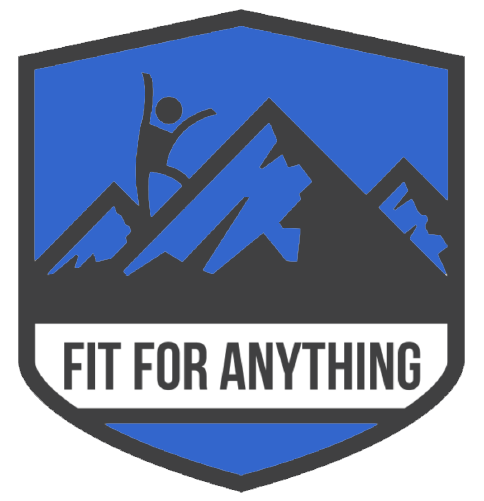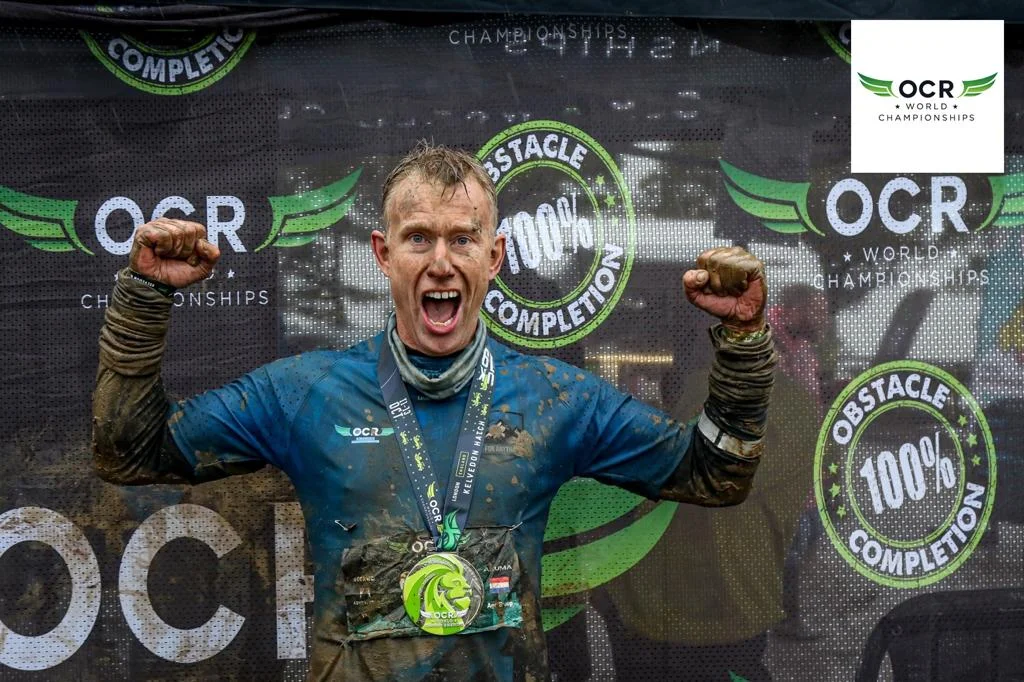After the Obstacle Course Racing (OCR) World Championships (WC ) which took place 11th-13th October 2019, I have been asked by many clients, friends and family HOW I completed the challenging 15km course, retaining my band and becoming 16th in the world within my age category.
The times have simply passed that qualifying participants were being able to get away with non-specific training and still being able to qualify for OCR European and World Championships. The OCR sport has evolved so much in the last 5 years, so many more people are competing, and obstacles have become increasingly technical and challenging. Completing the 15km course in poor conditions - the 12 degrees, plenty of water obstacles, a lot of mud and driving rain making it even more challenging, but the preparation for this event was very strategic at every level including preparing for these conditions.
The course had many casualties as was shown by the low number of pro participants able to complete it – with only 40% off men and 10% of females.
So for people wanting to know all the details of training, planning, nutrition and commitment required to complete it, here is my guide:
Training
The level of competing is at the highest, and as The World Championships is independent, it takes more to be successful than running - interval speed drills or building some stamina doing some long runs in the woods. It is also more than doing some Tough Mudder events, some press ups, pull ups and sit ups topped up with some basic strength training in the gym. The set-up of obstacles one after another is often set up to fatigue similar muscles on purpose which in turn saps muscle strength which has an impact on ability, agility, tactical awareness and mental strength. These developments continue to drive competitors on to become better and prepare accordingly.
Good foundations are a must such as possessing decent upper body strength as well as lower body, core strength, agility, astute with cardiovascular ability at the same time being calm, collective and coordinated. My background being a PT definitely helps with a firm base. An advantage to me is definitely that I played football and futsal at a semi-professional level and I did serve at The Royal Dutch Commando’s years ago and having gone through that certainly helps with both physical and mental strength.
Preparation requires a focus on quality total body movements and functional training is a must using training methods which assist to pull, push, grip, hang, run, jump, and crawl. I include activity to develop a full range of motion, to challenge soft tissue and to reduce the risk to injury.
Focus on strengths as well as any weaknesses – you simply can’t afford niggles and/ or be able to perform less than 95%. Then there is specific technique (running and obstacle) training. How to tackle obstacles such as tough low rigs and Gibbons. How to climb a 6-metre-long rope and what technique do you use when rope is dry or wet!? Practice makes perfect so you need to do and be able to adjust the body to the conditions and all of the above.
Here are 10 training things I do in addition to my normal training routine of 2-3 strength sessions a week:
1) I boulder regularly at The Arch North climbing centre in Edgware to develop agility, grip and forearm strength.
2) I train at least once a week on low rigs, ropes, monkey bars which I do at The Farm near Elstree where I also provide P.T. (OCR)training (usually Tuesday and Friday early afternoon).
3) I went to “P.T. Barn” near Corringham (an hour drive away) which is a specialised outdoor OCR centre with decent rigs and the latest obstacles to try such as Gibbons which commonly thought of among qualifiers as being the hardest obstacle at OCR WC. Team UK train there too and coach Scotty gave me some valuable pointers and techniques.
4) I have plenty of rings, hooks and other attachments hanging from the ceiling in my FFA gym at my house so I can practice hanging techniques, swinging, pulls and simulate rigs pretty much any day. It is great for the body to get used to volume, intensity and impact - this training assists muscle, tendon and joint stabilisation.
5) I jog cross country at least once a week and I often jog to the playground at Little Chalfont (7K) where there are pull up bars and other useful pieces of equipment to play with straight away - almost whilst running - all play to fatigue and without stopping jog 7K back, then time it and improve next time. I adjust my running program and distance training to the event(s) I will face but mainly to the event I want to excel the most at. Conditioning to the distance depends but usually about 6-8 weeks for most people.
6) I play tennis vigorously ones a week to gain agility, stamina and improve general fitness. The stop start runs side to side, front to back helps increase my mobility and functional movement too. I run riot for at least an hour in which I manage to burn 700 kcal just playing singles tennis with an ex-client (Anup Doshi) who is a top league player at Riverside David Lloyd in Northwood.
7) I am active and work each day of the week, I am on my feet at least 8 hours a day.
8) I address any niggle I may have - tightness, restriction of movement and/or injury by myself where I can - usually by enhancing blood flow, doing corrective strengthening work, improving posture, foam rolling, etc.
9) When struggling to address injuries, I go to someone who I trust who can assist me to resolve them. I saw James Ellis, a very good and famous osteopath who has looked after guys such as Usain Bolt. James is the Director of Active Healthcare in Farnham Common, who FFA has worked with for over 10 years. He has helped me to improve/resolve issues with my knees and shoulder over the past 5 months.
10) Depending on feel and need, I have had Sports Massages every 3 weeks, 2 months prior competing.
But it can’t be done on physical training alone – it requires preparation and commitment in terms of nutrition, support during the event and also recovery. Here are 10 key influencing factors for success:
1)Weight, body fat and muscle mass: It was important to be as lean as possible to reduce the stress on the body during hanging obstacles (especially with a shoulder injury) and whilst running in undulating terrain, but also to increase strength. In the 3 months leading up to the event I lost 2.3kg, mainly from my gut and increased my muscle mass by 2.7%.
2) Some top tips for dropping the weight without reducing performance was to eat simple foods, with lots of fruit and vegetables. I did not eat any carbohydrates on their own such as bread/pasta – particularly no starchy carbohydrates on what I call my “sweaty” (cardio) training days.
3) Drinking: You know that when training hard the correct hydration is required so a conscious effort to increase fluids was made. This unfortunately also included a resolution of pretty much NO alcohol for 2 months prior. This was quite tough as I do like the odd beer or glass of red wine but it is completely fine and you need to work on the mind-set that the end goal is worth the sacrifices. I found that a montmorency cherry juice concentrate with San Pellegrino sparkling water provided a reasonable alternative to wine, whilst also providing some essential vitamins and nutrients to boost well being.
4) Caffeine:Two months prior to the event I began to gradually reduce my intake of caffeine. This makes your body more sensitive to it so that energy supplements during the event have a magnified impact to prolong fatigue.
5) Nutritional supplements: Prior to the event you need to manage your supplementation to fill glycogen stores for energy burn. I used a carbo loader 2 days prior( 5 scoops) in a 70cl water bottle, Double this during 1 day before, then the last carbo load just one bottle 2 hours before race time.
6) Race day supplementation: I use 3 different forms of supplementation during the race carried in my race pack, which include magnesium supplements, lemon gels to replace electrolytes from sweating and Scivation which supports muscle function, replenishes electrolytes and it also contains caffeine for energy boost and enhanced focus. I planned the quantity and what I would need to take at various points around the course based on previous experience.
7) Recovery: It is important not to let your body fall too quickly into recovery mode following an event. You want to prolong the after effects of such a demand on your body. Good nutrition in the lead-up will help, I love a decent steak the night before, with plenty of vegetables and some sautéed potatoes. Immediately after such an extreme event I use two Born magnesium liquid and Vitamin C shots to avoid immediate cramping followed with normal hydration and a protein drink. Once home I have a bath with some Tisserand muscle ease bath oil and I use its body ease massage and body oil for my skin afterwards.
8) Previous event experience race preparation: You can learn a lot from previous event preparation – for this event the The Winter Nuts Challenge event experience helped greatly - it is about recognising what works for you personally in all aspects including weather conditions, where your weaknesses are and building yourself physically and mentally to improve and overcome. You need to plan time to increase your training gradually so that you keep your immunity up, improve total performance and prolong fatigue.
9) Support during event: My family support during the event was a huge boost to me mentally, but also physically as they helped to cheer me on throughout the event, as well as ensure that I remembered to take my energy supplements at strategic points of the course to keep me sustained for the 3 hours and 45 minutes. They were also ready and waiting with warm gear and recovery supplements for me to take as soon as I finished. I think they were as muddy, wet and cold as I was!
10) Be nice to your family! The training required takes its toll on family life. My wife is very understanding – not only of the commitment to prepare, but also the after effects! The bruises, the mud still appearing 3 days later, the day to clean the car from the journey home not to mention the effects of the washing on the machine!




